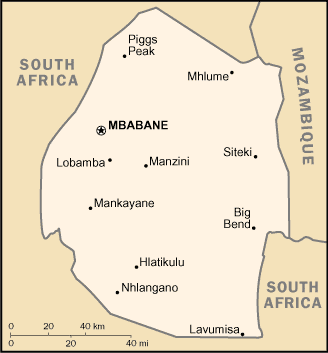Swaziland
Map Courtesy CIA World Factbook
Human remains and artifacts from more than 100,000 years ago have been found in Swaziland. Evidence of agriculture and iron use dates from about the 4th century, and people speaking languages ancestral to current Sotho and Nguni languages began settling no later than the 11th century. The ruling Dlamini lineage had chiefships in the region in the 18th century. An enlarged Swazi kingdom was established by Sobhuza I in the early 19th century. Soon thereafter the first whites started to settle in the area. In the 1890s the South African Republic in the Transvaal claimed sovereignty over Swaziland but never fully established power. After the South African War of 1899-1902, Swaziland became a British protectorate. The country was eventually granted independence on September 6, 1968. Since then, Swaziland has seen a struggle between pro-democracy activists and the totalitarian monarchy.
|
||||||||||||||

 The Kingdom of Swaziland is a small country in southern Africa (one of the smallest on the continent), situated on the eastern slope of the Drakensberg mountains, embedded between South Africa in the west and Mozambique in the east. The country is named after the Swazi, a Bantu tribe.
The Kingdom of Swaziland is a small country in southern Africa (one of the smallest on the continent), situated on the eastern slope of the Drakensberg mountains, embedded between South Africa in the west and Mozambique in the east. The country is named after the Swazi, a Bantu tribe.